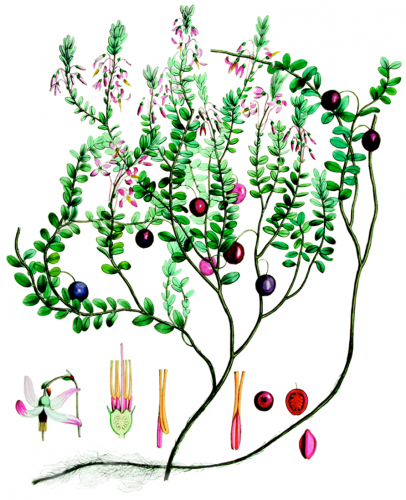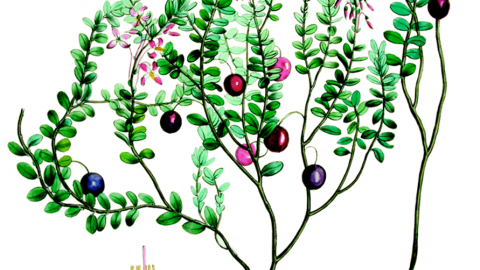Consider the Cranberry
Seasonal holiday food seems largely liberated from its once-a-year offering. I think about how the sweet potato used to show up at the table only in late November. Same goes for the cranberry, right? Not anymore. In fact, 95% of the U.S. cranberry harvest is consumed year-round in the form of juice. The other 5% is harvested for fresh berries sold in the produce section after the fall harvest.
Cranberries have specific cultural requirements, so they can only be grown in certain parts of the country. Most commercial cranberry farms are located in natural or man-made bogs where a system of wetlands, uplands, ditches and bodies of water work together to create the perfect growing and harvesting environment. The original cranberry bogs in Massachusetts, for example, resulted from the last glacial deposit over 10,000 years ago. Ice carved out depressions that filled with water. As organic matter accumulated over layers of clay and sand blew in from the coast, a bog was born that created just the right environment for this native food plant to thrive.
The Wampanoag harvested cranberries and made pemmican, an American Indian travel food made of pounded dried meat, grains, animal fat and cranberries (the perfect combination of nutrients) expe
in present-day Massachusetts, there is also considerable production taking place in New Jersey, Wisconsin, Washington and Oregon. Interestingly, too, the varieties cultivated today are largely the same varieties that were developed in the mid 1800s, after Captain Henry Hall began cultivating the first wild bog in 1817.
During the growing season, which lasts from April to November, the bogs are drained and the cranberry vines grow in impermeable fields that allow for flooding just prior to harvest. Glacial deposits created true bogs, but today cranberry farmers can create bogs by layering sand, peat, gravel and clay. The bottommost layer of clay allows for flooding later in the season while the sand, peat and gravel provide the cultural requirements of well-drained, acidic soil that cranberries must have to thrive. The plant is a low-growing perennial vine. Imagine the sight of a cranberry bog stretching out in front of you in full bloom in June and July. This is also when the honey and bumble bees are trucked in and hives are set up in the bogs for the extra “migratory” bees to maximize pollination.
There are two methods used for harvesting cranberries: dry harvesting and wet harvesting. The firm cranberries we can buy fresh at the market in November are typically harvested dry by a machine that looks like a walk-behind mower. Fresh, dry-harvested cranberries account for about 5% of the harvest. The other 95% of the cranberries are harvested wet and this is a sight to behold.
Growers begin flooding their bogs just prior to harvest. Once the water level reaches about 18 inches they send in the water reels. The reels stir the water, which loosens the berries. Since cranberries are buoyant, they all float to the surface, bobbing about until they are corralled and loaded onto trucks to be sorted.
Sorting cranberries is all about the bounce: An early cranberry farmer named John “Peg Leg” Webb accidently invented the bounce test for sorting out rotting berries from fresh. John “Peg Leg” wasn’t nicknamed “Peg Leg” for nothing. He could not carry his cranberries down from the loft of his barn so he would pour them down the steps and collect them at the bottom. He noticed a recurring theme: the firmest fruit bounced all the way down and the soft, rotting fruit remained on the stairs. The bounce-board separator developed in the 1920s is still used today to sort cranberries.
The flooding of bogs is also utilized for winter protection. The frozen water acts as insulation and protection against frost and heavy snow damage. It also sets the stage for ice sanding. Every three to five years when the ice is frozen solid, equipment can drive over the plants in order to apply new layers of sand to the bog. When the ice and snow begin to melt the sand penetrates the cranberries, the bogs are drained and the plants break dormancy and begin the cycle again. In the wild environment this sand would blow in from the coast naturally.
Perennial fruit crops like the cranberry need adequate chilling hours. “Chilling hours” refers to the amount of time temperatures remain under 45°F. This dormancy is important for bud formation, the timing of bud break and consequently how vulnerable a plant is to a late frost or freeze. Here is an example of global warming’s impact on food production: 75% of the 2017 Georgia peach crop was a bust because of low chilling hours. Peaches need around 850 hours to ripen and last year they got just 500 last. In addition to low chill there was also a March freeze that easily damaged trees across the state because they had already broken dormancy.
Fruit is a risky business to begin with if you just consider pest pressure; add diminishing bee populations and warm winters and it may get even riskier! The state of Oregon has had some warm fall weather and Extension Specialists there believe low chilling hours may be the reason they are seeing higher rates of “umbrella bloom” in their cranberry crop: new shoots that are topped with bloom but no new foliar growth. Plants need foliage to photosynthesize so the long-term effect will mean less vigorous plants. So it seems, the art of growing cranberries really is a well-oiled machine.
Vaccinium macrocarpon, or the cranberry, used to be called the “crane berry.” When the colonists first learned of this berry from their American Indian hosts in the New World they thought the blooms of the native vine looked like the long neck and bill of a crane. Eventually, it was shortened to cranberry.
rtly preserved in a chewy pocket-sized bar. In the 19th century whalers, sailors and soldiers munched dried cranberries for vitamin C to stave off scurvy. Although commercial cultivation still takes place in those long ago carved out bogs






